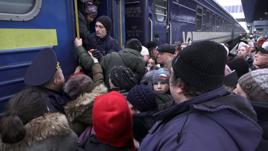Ben Jones discovers some of the risks that Ukrainian Railways frontline staff take to keep their essential trains moving - something YOU can help with, from as little as £20.
It’s the middle of the night. You’re part of a permanent way team carrying out track repairs on a main line deep in the countryside. The only relief from the pitch black are head torches and maybe a couple of portable work lights. It’s tough, physical and tiring work at the best of times, but at night it’s even more dangerous.
Now imagine doing it in a live war zone, ears pricked for the sound of missiles and shells streaking over your head, terrified about stumbling across unexploded live ordnance.
That’s the scenario Ukrainian railway workers have had to face day in, day out since Russia launched its invasion in February 2022.
Many readers will have seen the widely shared images of unexploded bombs lodged into embankments and railway infrastructure shattered by rocket attacks and suicide drones, but the real dangers are often less obvious. Swathes of eastern Ukraine are now peppered with landmines, making it difficult to ensure the safety of rail workers on the ground.
“We are the last ones to leave when Russian forces advance, and the first to return when Ukrainian forces liberate occupied territory,” said Oleg Yakovenko, director of strategy and transformation at Ukrzaliznytsia (UZ) on his recent visit to Rail Live in the UK (RAIL 1013).
“Railway workers are constantly under enemy fire,” he added.
“Our engineers, conductors, track workers, repair crews, electricians and other colleagues work with dedication, risking their own lives and health to ensure the uninterrupted operation of the railway arteries of our country and to save the lives of others under any circumstances.
“Our mission to save people continues and will last as long as needed.
“Our colleagues demonstrate daily heroism, maximum endurance and courage. For example, under combat conditions, engineers from the Khrystynivka depot brought out three diesel trains from Mykolaiv.
“On another occasion, a track worker from the Odesa Division found an explosive device planted by saboteurs and alerted the military. An instructor engineer from Mykolaiv depot, despite the constant shelling of Kherson, evacuated all 2TE-10 and ChME-3 series locomotives. And these are just a few examples among many.
“Unfortunately, some of our colleagues lose their lives or are injured while performing their duties. On August 24 2022, Russian forces struck the village of Chaplyne in the Dnipropetrovsk region with four missiles. Five railway workers were killed and three were wounded.”
Sadly, such stories are common.
Railway workers co-operate closely with State Emergency Services and are often involved in eliminating accidents, the aftermath of enemy shelling, natural disasters, and more.
Since the beginning of the full-scale invasion, Ukrainian Railways’ fire departments have been dispatched more than 120 times to extinguish large-scale fires caused by enemy missile attacks.
Essential maintenance
With a network of 12,241 miles and a workforce of 187,000, UZ is the world’s sixth largest passenger rail carrier and the seventh largest rail freight transporter. It carries 62% of Ukraine’s freight traffic (far above the European average) and 25% of passenger journeys.
Since February 24 2022, more than 6,000km (3,728 miles) of the company’s tracks have been damaged and hundreds of essential items of railway infrastructure have been damaged beyond repair, including bridges, depots, substations and freight facilities.
Many of Ukraine’s most important generators of freight traffic, the vital coal and steel regions around Donetsk and agricultural exports via Black Sea ports, currently lie in occupied territory, significantly reducing UZ’s income.
However, operational and infrastructure activities have been radically modified to cope with the crisis.
The focus has shifted to the reorganisation of traffic to ensure reliability and rapid repair of damaged equipment and infrastructure.
For example, a strategic bridge at Irpin, on the outskirts of Kyiv, was rebuilt and reopened in just 29 days after being damaged by Russian attacks in the early days of the invasion.
Immediately after the liberation of Ukrainian territories, UZ restored full railway connections for Kherson and several towns and villages in the Chernihiv and Sumy regions.
To restore service to Chernihiv, workers had to repair several enemy-damaged items of infrastructure within a short timeframe: hundreds of kilometres of tracks, a bridge, an overpass and contact networks.
To date, 46 of 83 damaged bridges have been repaired, 25.8km (16 miles) of track have been repaired (from a total of 52.2km (32 miles) damaged), and just over half of the 1,413km (878 miles) of overhead line equipment destroyed has been restored. In the latter case, diesel traction has been deployed to keep services running on lines where the OLE has been disabled.
For 2025-26, UZ’s priorities include a rehabilitation of assets including electricity sub-stations and bridges, repair and reconstruction of bridges, tracks, signalling and communication systems.
UZ is also spending around €200 million (£169m) on protecting essential assets, including the construction of underground traction sub-stations and diesel fuel storage facilities to protect them from attacks.
Protective equipment
More than 10,000 UZ employees have been drafted into the armed forces and many more remain with UZ in frontline regions in the east and southeast of Ukraine.
Rail Partners’ Kit for Kyiv initiative marks a change from emergency aid packages (RAIL 1013) to the supply of protective equipment such as helmets and body armour. Requirements include almost 5,000 helmets and more than 5,700 protective vests, allowing railway staff to continue their work in dangerous environments.
Since the beginning of the war, more than 680 UZ employees have been killed, 19 of them while on duty, and more than 1,840 have been wounded. Around 10,000 railway workers and their families have been displaced from conflict regions.
Despite this, more than four million people (including a million children) and 120,000 pets have been transported away from frontline areas to safety in western Ukraine or further afield.
Since the beginning of 2024, UZ has carried 13.3 million passengers, 2.4 million more than the same period last year.
International passengers have also increased, from 890,000 to 1.1 million, as displaced Ukrainians use new and revived cross-border routes to travel home to see their families.
How to support Kit for Kyiv!
- To make donations and for more information on the initiative, visit: https://www.we-aid.org/en/initiatives/allrail-support-ukraine-rail-task-force/
- For industry colleagues, to find out more about how you can support colleagues at Ukrainian Railways, contact [email protected]
- To see a list of corporate donors and to find out more about Rail Partners with Ukraine and #KitForKyiv, visit https://www.railpartners.co.uk/ukraine
- Kit for Kyiv is being run in conjunction with the international Global Ukraine Rail Task Force, with all donations in Sterling going directly into the campaign.















Login to comment
Comments
No comments have been made yet.